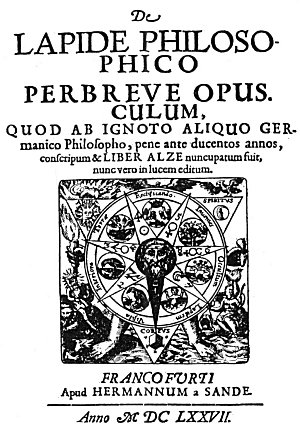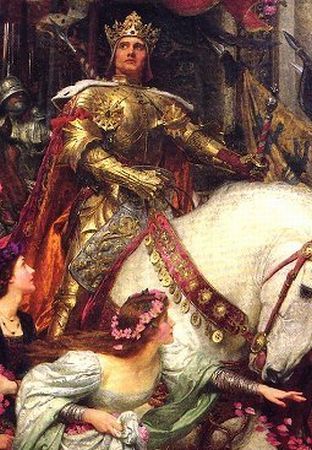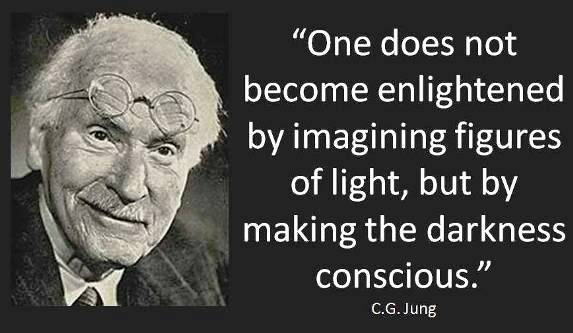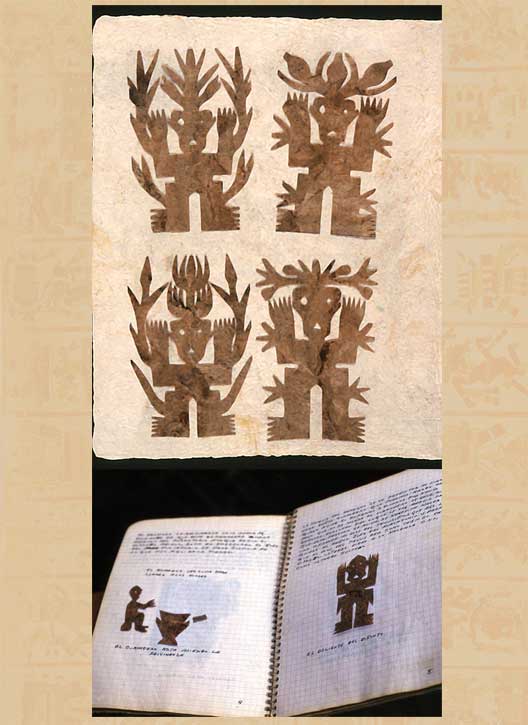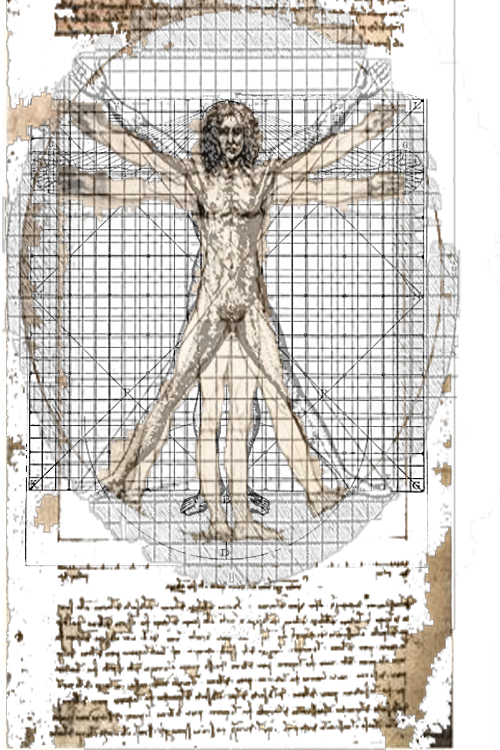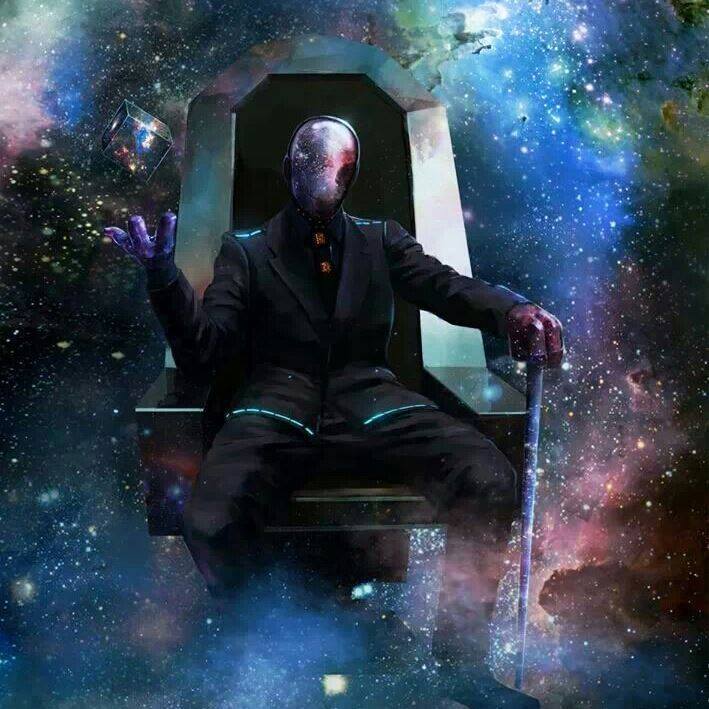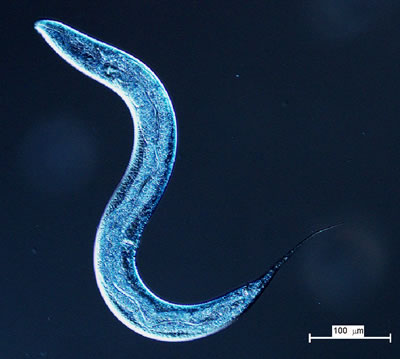p. A4
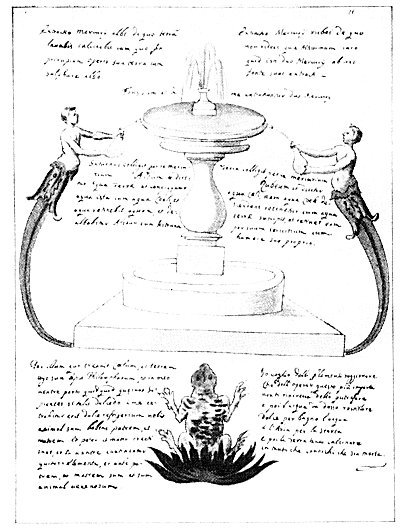 Leaf 11. The fount is described as that from which the two Mercuries of the Philosophers are extracted. At the upper left is described the white Mercury and at the right the red Mercury. The text about the fountain declares that Saturn collects the white Mercury, which is called the Water of Earth; and the Earth collects the red Mercury, which is called the Water of Heaven. The text to the left of the frog reads: “Through Him who created the Heavens and the Earth I am the Philosopher’s Stone, and in my body I carry something the wise seek. If such a charm be extracted from me, it will be a sweet refreshment for you. I am an animal having father and mother, and father and mother were created; and in my body are contained the four elements, and I am before father and mother and I am a poisonous animal.” The lines at the right describe distilling and calcining processes.
Leaf 11. The fount is described as that from which the two Mercuries of the Philosophers are extracted. At the upper left is described the white Mercury and at the right the red Mercury. The text about the fountain declares that Saturn collects the white Mercury, which is called the Water of Earth; and the Earth collects the red Mercury, which is called the Water of Heaven. The text to the left of the frog reads: “Through Him who created the Heavens and the Earth I am the Philosopher’s Stone, and in my body I carry something the wise seek. If such a charm be extracted from me, it will be a sweet refreshment for you. I am an animal having father and mother, and father and mother were created; and in my body are contained the four elements, and I am before father and mother and I am a poisonous animal.” The lines at the right describe distilling and calcining processes.
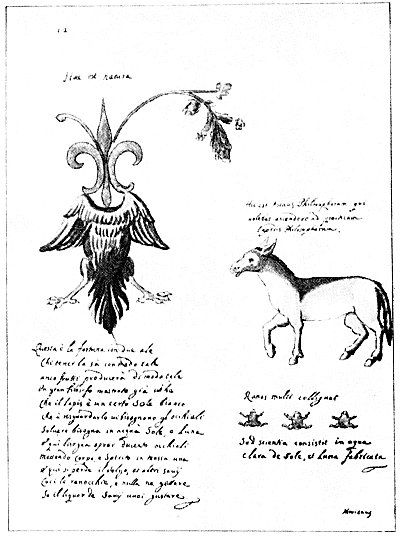 Leaf 12. The three words at the top read: “This is Nature.” The lines above the donkey read: “This is the Philosophers’ donkey who wished to rise to the practice of the Philosopher’s Some.” The three lines below the animal are translated: “Frogs gather in multitudes but science consists of clear water made from the Sun and Moon.” The text under the symbolic bird is as follows: “This is fortune with two wings. Whosoever has it knows that fruit will in such away be produced. A great philosopher has shown that the stone is a certain white sun, to see which needs a telescope. To dissolve it in water requires the Sun and Moon, and here one must open 200 telescopes, putting body and soul in one mass. And here is lost the mass; other sages cook the frogs and add nothing, if the juice of the Wise you wish to enjoy.” To the Greeks the frog symbolized both metempsychosis and earthly humidity.
Leaf 12. The three words at the top read: “This is Nature.” The lines above the donkey read: “This is the Philosophers’ donkey who wished to rise to the practice of the Philosopher’s Some.” The three lines below the animal are translated: “Frogs gather in multitudes but science consists of clear water made from the Sun and Moon.” The text under the symbolic bird is as follows: “This is fortune with two wings. Whosoever has it knows that fruit will in such away be produced. A great philosopher has shown that the stone is a certain white sun, to see which needs a telescope. To dissolve it in water requires the Sun and Moon, and here one must open 200 telescopes, putting body and soul in one mass. And here is lost the mass; other sages cook the frogs and add nothing, if the juice of the Wise you wish to enjoy.” To the Greeks the frog symbolized both metempsychosis and earthly humidity.
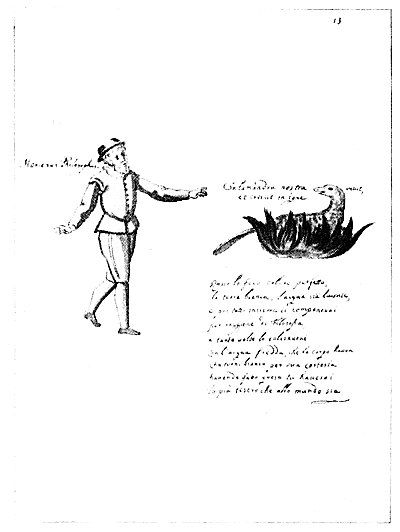 Leaf 13. This Page contains but two figures. At the left stands Morienus, the philosopher, pointing towards the salamander who “lives and grows in fire.” Morienus, who was born in the twelfth century, became the disciple of the great Arabian alchemist Adfar, from whom he learned the Hermetic arts. Morienus prepared the Philosophical Elixir for the Sultan of Egypt, inscribing upon the vase in which he placed the precious substance the words: “He who possesses all has no need of others.” He spent many years as a hermit near Jerusalem. The lines below the salamander are: “Let the fire be of a perfect red color; the earth white, the water clear. Then compound them by philosophical means and calcine them as many times with the water which the body had as to turn it white by its kindness. Having done this, you will have the greatest treasure in the world.”
Leaf 13. This Page contains but two figures. At the left stands Morienus, the philosopher, pointing towards the salamander who “lives and grows in fire.” Morienus, who was born in the twelfth century, became the disciple of the great Arabian alchemist Adfar, from whom he learned the Hermetic arts. Morienus prepared the Philosophical Elixir for the Sultan of Egypt, inscribing upon the vase in which he placed the precious substance the words: “He who possesses all has no need of others.” He spent many years as a hermit near Jerusalem. The lines below the salamander are: “Let the fire be of a perfect red color; the earth white, the water clear. Then compound them by philosophical means and calcine them as many times with the water which the body had as to turn it white by its kindness. Having done this, you will have the greatest treasure in the world.”
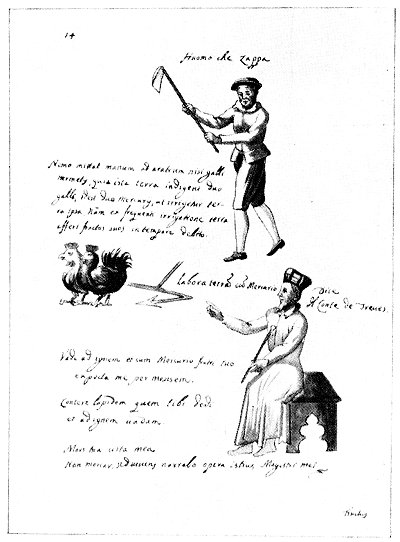 Leaf 14. The three words at the top of the left page are translated: “The man that digs.” Above the birds it is declared that none but the cocks of Hermes, the two Mercuries, shall put hand to the plow, and only after irrigation will the earth bring forth her fruits. The seated man is Count Bernard of Treviso, who says: “Work the earth with Mercury.” (See chapter on Alchemy and Its Exponents.) The three sentences to the Count’s left read: “Go to the fire and with Mercury, thy brother, await me for a month. Crumble the stone I gave thee and I shall go to the fire. Thy death, my life. I shall net die but, living, tell of the works of this, my master.” Bernard of Treviso in his alchemical speculation emphasized the necessity of meditation upon the philosophical writings of the great adepts rather than chemical experimentation. He ultimately discovered the “Stone.”
Leaf 14. The three words at the top of the left page are translated: “The man that digs.” Above the birds it is declared that none but the cocks of Hermes, the two Mercuries, shall put hand to the plow, and only after irrigation will the earth bring forth her fruits. The seated man is Count Bernard of Treviso, who says: “Work the earth with Mercury.” (See chapter on Alchemy and Its Exponents.) The three sentences to the Count’s left read: “Go to the fire and with Mercury, thy brother, await me for a month. Crumble the stone I gave thee and I shall go to the fire. Thy death, my life. I shall net die but, living, tell of the works of this, my master.” Bernard of Treviso in his alchemical speculation emphasized the necessity of meditation upon the philosophical writings of the great adepts rather than chemical experimentation. He ultimately discovered the “Stone.”
p. A5
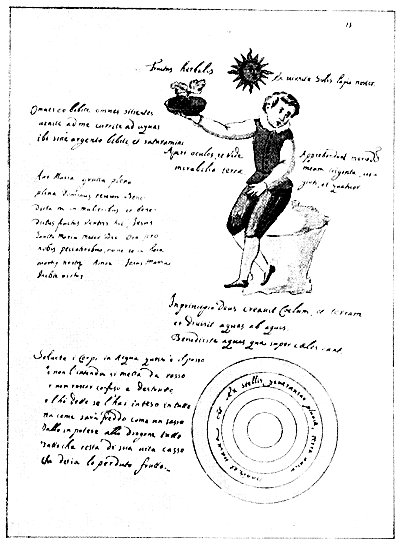 Leaf 15. The first sentence reads: “The fruit of plants by virtue of the Sun, our Stone.” The boy holding the dish is made to say: “Drink here all ye that are athirst. Come unto me, run to the waters. Here drink, without price, and drink your fill. Open your eyes and see the wonders of the earth. They learn, my thirsty twenty and four.” Beneath the boy are the words: “In the beginning God created the Heavens and the Earth, and divided the waters from the waters. Bless the waters which are above the Heavens.” The circle contains this statement: “The earth without form and void. Out of the stars come the rains.” The lower left panel continues the alchemical process, ending with admonition to renounce the misery of worldly existence. Above is a prayer to the Virgin Mary which opens thus: “Hail Mary, full of grace, the Lord be with thee. Blessed thou among women.”
Leaf 15. The first sentence reads: “The fruit of plants by virtue of the Sun, our Stone.” The boy holding the dish is made to say: “Drink here all ye that are athirst. Come unto me, run to the waters. Here drink, without price, and drink your fill. Open your eyes and see the wonders of the earth. They learn, my thirsty twenty and four.” Beneath the boy are the words: “In the beginning God created the Heavens and the Earth, and divided the waters from the waters. Bless the waters which are above the Heavens.” The circle contains this statement: “The earth without form and void. Out of the stars come the rains.” The lower left panel continues the alchemical process, ending with admonition to renounce the misery of worldly existence. Above is a prayer to the Virgin Mary which opens thus: “Hail Mary, full of grace, the Lord be with thee. Blessed thou among women.”
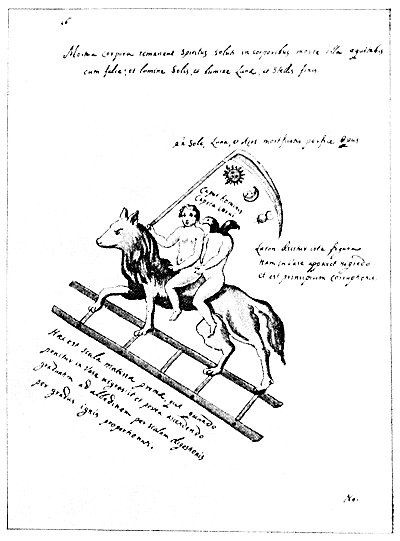 Leaf 16. The first sentence reads: “The dead bodies remain; the spirits are freed by the death in the bodies. You will ride with that death with a scythe, and the light of the Sun, the Moon, and the fixed stars.” Over the scythe is written: “Subject to the Sun, the Moon and Azoth, complete the Work.” The four words in the curve of the scythe blade say: “Man’s head, head of raven.” The three lines to the right are interpreted thus: “This figure is called Laton, for it looks black in a vessel, and is the beginning of corruption.” The text below the ladder states: “This is the ladder of primitive matter which when placed in a vessel turns black, the gradually changes to white by the scale [ladder] of digestion, according to the degree of heat.” Here a ladder is used to signify the natural steps up which matter must ascend before it can attain to a truly spiritual state.
Leaf 16. The first sentence reads: “The dead bodies remain; the spirits are freed by the death in the bodies. You will ride with that death with a scythe, and the light of the Sun, the Moon, and the fixed stars.” Over the scythe is written: “Subject to the Sun, the Moon and Azoth, complete the Work.” The four words in the curve of the scythe blade say: “Man’s head, head of raven.” The three lines to the right are interpreted thus: “This figure is called Laton, for it looks black in a vessel, and is the beginning of corruption.” The text below the ladder states: “This is the ladder of primitive matter which when placed in a vessel turns black, the gradually changes to white by the scale [ladder] of digestion, according to the degree of heat.” Here a ladder is used to signify the natural steps up which matter must ascend before it can attain to a truly spiritual state.
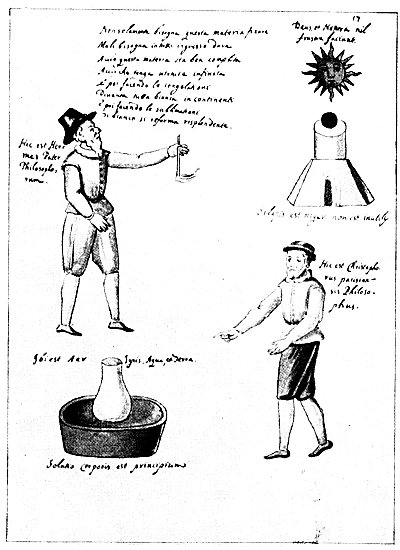 Leaf 17. The verse at the top of the page reads: “Not only must this material be fixed, but it must be allowed to enter into everything so that this material may be well completed and have infinite virtue. Then by making it thick, it becomes at once all white, sublimation from white it becomes shining.” Above the sun are the words: “God and Nature do nothing in vain.” The man on the left is a mediæval conception of Hermes, the great Egyptian philosopher; the one on the right is Christopher, the philosopher of Paris. Above the latter is written: “If the Stone is black, it is not useless.” The words over the retort are: “There is air, fire, water, and earth.” Below is added: “A dissolution of the body is the first step. ” The curious chemical apparatus must be considered purely symbolic in this work and, as its author himself says, is intended to give only a hint of the “Art.”
Leaf 17. The verse at the top of the page reads: “Not only must this material be fixed, but it must be allowed to enter into everything so that this material may be well completed and have infinite virtue. Then by making it thick, it becomes at once all white, sublimation from white it becomes shining.” Above the sun are the words: “God and Nature do nothing in vain.” The man on the left is a mediæval conception of Hermes, the great Egyptian philosopher; the one on the right is Christopher, the philosopher of Paris. Above the latter is written: “If the Stone is black, it is not useless.” The words over the retort are: “There is air, fire, water, and earth.” Below is added: “A dissolution of the body is the first step. ” The curious chemical apparatus must be considered purely symbolic in this work and, as its author himself says, is intended to give only a hint of the “Art.”
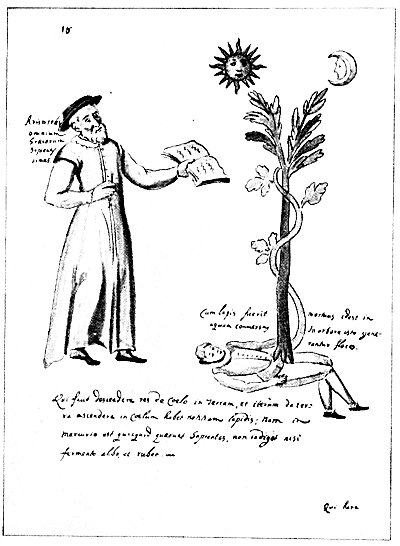 Leaf 18. At the left holding a book stands Aristotle, who is described as the most learned of all the Greeks. The tree surmounted by the Sun and Mon. is accompanied by the wards: “When the Stone is dead, that is changed to water, in this it will produce flowers.” Beneath Aristotle and the prostrate human figure from which rises the flowering tree are these statements: “He who makes everything descend from heaven to earth, and then ascend from earth to heaven, has information about the Stone. For in Mercury there is something the wise seek, not invoked except by white or red ferment.” The first part of this quotation is based upon the Emerald Tablet of Hermes (which see). In ordinary man, the spirit is figuratively absorbed by the body; but in the true philosopher, the spirit is so greatly increased in power that it absorbs into itself and is nourished by man’s corporeal body.
Leaf 18. At the left holding a book stands Aristotle, who is described as the most learned of all the Greeks. The tree surmounted by the Sun and Mon. is accompanied by the wards: “When the Stone is dead, that is changed to water, in this it will produce flowers.” Beneath Aristotle and the prostrate human figure from which rises the flowering tree are these statements: “He who makes everything descend from heaven to earth, and then ascend from earth to heaven, has information about the Stone. For in Mercury there is something the wise seek, not invoked except by white or red ferment.” The first part of this quotation is based upon the Emerald Tablet of Hermes (which see). In ordinary man, the spirit is figuratively absorbed by the body; but in the true philosopher, the spirit is so greatly increased in power that it absorbs into itself and is nourished by man’s corporeal body.

Moe is the founder of GnosticWarrior.com. He is a father, husband, author, martial arts black belt, and an expert in Gnosticism, the occult, and esotericism.

![How Claudius, the second of the Romans who came into Britain, brought the islands Orcades into subjection to the Roman empire; and Vespasian, sent by hint, reduced the Isle of Wight under the dominion of the Romans [44 AD] | Book 1 | Chapter 3 How Claudius, the second of the Romans who came into Britain, brought the islands Orcades into subjection to the Roman empire; and Vespasian, sent by hint, reduced the Isle of Wight under the dominion of the Romans [44 AD] | Book 1 | Chapter 3](https://www.gnosticwarrior.com/wp-content/plugins/contextual-related-posts/default.png)
